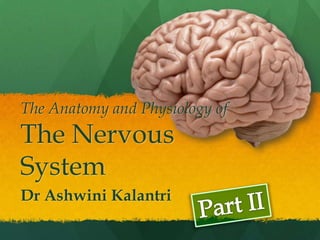
Nervous system 2
- 1. The Anatomy and Physiology of The Nervous System Dr Ashwini Kalantri
- 2. Nervous System Central Nervous Peripheral Nervous System System Motor Sensory Brain Spinal Cord Neurons Neurons Somatic Autonomic N.S. N.S. Sympathetic Parasympathetic
- 3. Sympathetic Nervous System Fight or flight Organ Effect Eye Dilates pupil Heart Increases rate and force of contraction Lungs Dilates bronchioles Blood Vessels Constricts Sweat Glands Activates sweat secretion Digestive tract Inhibits peristalsis Penis Promotes ejaculation
- 4. Parasympathetic Nervous System Works opposite to the sympathetic nervous system Tries to keep the body at rest.
- 5. Functions of the Nervous System Sensory Function Sensory receptors gather information Information is carried to the CNS
- 6. Functions of the Nervous System Motor Function Decisions are acted upon Impulses are carried to effectors
- 7. Functions of the Nervous System Integrative Function Sensory information used to create: Sensations Memory Thoughts Decisions
- 8. Neural Cells Cell types in neural tissue: Neurons Neuroglial cells (also known as neuroglia, glia, and glial)
- 9. Neurons
- 10. Myelination of Axons White Matter Contains myelinated axons Considered fiber tracts Gray Matter Contains unmyelinated structures Cell bodies, dendrites
- 11. Multipolar Bipolar Unipolar
- 12. How does the nerve transmit a signal?
- 13. Cell Membrane Potential A cell membrane is usually electrically charged, or polarized, so that the inside of the membrane is negatively charged with respect to the outside of the membrane. This is as a result of unequal distribution of ions on the inside and the outside of the membrane.
- 14. Distribution of Ions Potassium (K+) ions are the major intracellular positive ions (cations). Sodium (Na+) ions are the major extracellular positive ions (cations). This distribution is largely created by the Sodium/Potassium Pump (Na+/K+ pump). This pump actively transports sodium ions out of the cell and potassium ions into the cell. Also due to the presence of ion-selective channels
- 15. Resting Potential Resting Membrane Potential (RMP): It is a polarized membrane Inside of cell is negative relative to the outside of the cell, due to distribution of ions inside vs. outside Na+/K+ pump restores 70 mV difference from inside to outside of cell RMP = -70 mV
- 16. Local Potential Changes Caused by various stimuli: Temperature changes Light Pressure Environmental changes affect the membrane potential by opening a gated ion channel Channels are 1) chemically gated, 2) voltage gated, or 3) mechanically gated
- 17. Local Potential Changes If membrane potential becomes more negative, it has hyperpolarized If membrane potential becomes less negative, it has depolarized Graded (or proportional) to intensity of stimulation, meaning the greater the stimulation, the greater the depolarization If the depolarization is great enough, reach threshold potential Reaching threshold potential results in a nerve impulse, starting an action potential
- 18. Action Potentials +40 Action potential +20 Membrane potential (millivolts) 0 –20 Resting potential reestablished –40 Resting potential –60 –80 Hyperpolarization 0 1 2 3 4 5 6 7 8 Milliseconds
- 19. Pathways
- 20. Dr Ashwini Kalantri +91 9860598097 cell phone ak@ashwini.co.in email
